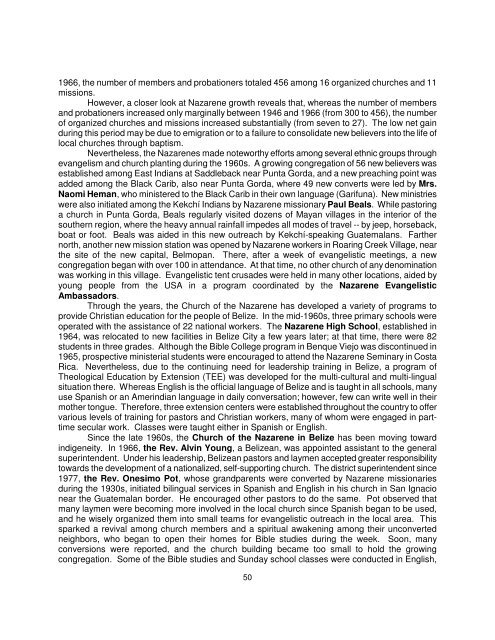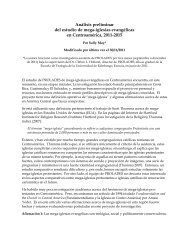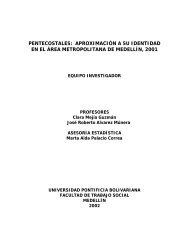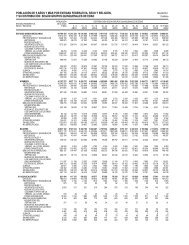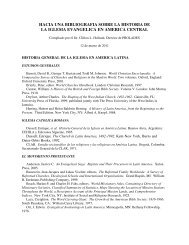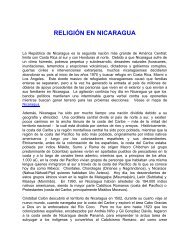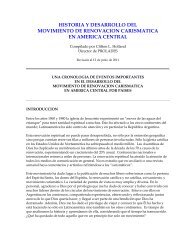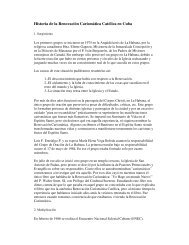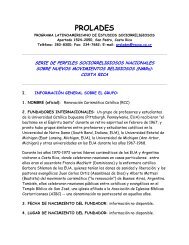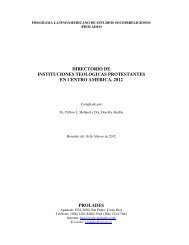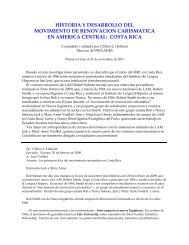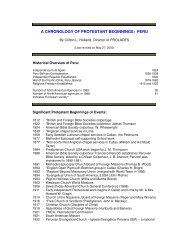belize, 1980 - Prolades.com
belize, 1980 - Prolades.com
belize, 1980 - Prolades.com
You also want an ePaper? Increase the reach of your titles
YUMPU automatically turns print PDFs into web optimized ePapers that Google loves.
1966, the number of members and probationers totaled 456 among 16 organized churches and 11<br />
missions.<br />
However, a closer look at Nazarene growth reveals that, whereas the number of members<br />
and probationers increased only marginally between 1946 and 1966 (from 300 to 456), the number<br />
of organized churches and missions increased substantially (from seven to 27). The low net gain<br />
during this period may be due to emigration or to a failure to consolidate new believers into the life of<br />
local churches through baptism.<br />
Nevertheless, the Nazarenes made noteworthy efforts among several ethnic groups through<br />
evangelism and church planting during the 1960s. A growing congregation of 56 new believers was<br />
established among East Indians at Saddleback near Punta Gorda, and a new preaching point was<br />
added among the Black Carib, also near Punta Gorda, where 49 new converts were led by Mrs.<br />
Naomi Heman, who ministered to the Black Carib in their own language (Garifuna). New ministries<br />
were also initiated among the Kekchí Indians by Nazarene missionary Paul Beals. While pastoring<br />
a church in Punta Gorda, Beals regularly visited dozens of Mayan villages in the interior of the<br />
southern region, where the heavy annual rainfall impedes all modes of travel -- by jeep, horseback,<br />
boat or foot. Beals was aided in this new outreach by Kekchí-speaking Guatemalans. Farther<br />
north, another new mission station was opened by Nazarene workers in Roaring Creek Village, near<br />
the site of the new capital, Belmopan. There, after a week of evangelistic meetings, a new<br />
congregation began with over 100 in attendance. At that time, no other church of any denomination<br />
was working in this village. Evangelistic tent crusades were held in many other locations, aided by<br />
young people from the USA in a program coordinated by the Nazarene Evangelistic<br />
Ambassadors.<br />
Through the years, the Church of the Nazarene has developed a variety of programs to<br />
provide Christian education for the people of Belize. In the mid-1960s, three primary schools were<br />
operated with the assistance of 22 national workers. The Nazarene High School, established in<br />
1964, was relocated to new facilities in Belize City a few years later; at that time, there were 82<br />
students in three grades. Although the Bible College program in Benque Viejo was discontinued in<br />
1965, prospective ministerial students were encouraged to attend the Nazarene Seminary in Costa<br />
Rica. Nevertheless, due to the continuing need for leadership training in Belize, a program of<br />
Theological Education by Extension (TEE) was developed for the multi-cultural and multi-lingual<br />
situation there. Whereas English is the official language of Belize and is taught in all schools, many<br />
use Spanish or an Amerindian language in daily conversation; however, few can write well in their<br />
mother tongue. Therefore, three extension centers were established throughout the country to offer<br />
various levels of training for pastors and Christian workers, many of whom were engaged in parttime<br />
secular work. Classes were taught either in Spanish or English.<br />
Since the late 1960s, the Church of the Nazarene in Belize has been moving toward<br />
indigeneity. In 1966, the Rev. Alvin Young, a Belizean, was appointed assistant to the general<br />
superintendent. Under his leadership, Belizean pastors and laymen accepted greater responsibility<br />
towards the development of a nationalized, self-supporting church. The district superintendent since<br />
1977, the Rev. Onesimo Pot, whose grandparents were converted by Nazarene missionaries<br />
during the 1930s, initiated bilingual services in Spanish and English in his church in San Ignacio<br />
near the Guatemalan border. He encouraged other pastors to do the same. Pot observed that<br />
many laymen were be<strong>com</strong>ing more involved in the local church since Spanish began to be used,<br />
and he wisely organized them into small teams for evangelistic outreach in the local area. This<br />
sparked a revival among church members and a spiritual awakening among their unconverted<br />
neighbors, who began to open their homes for Bible studies during the week. Soon, many<br />
conversions were reported, and the church building became too small to hold the growing<br />
congregation. Some of the Bible studies and Sunday school classes were conducted in English,<br />
50


